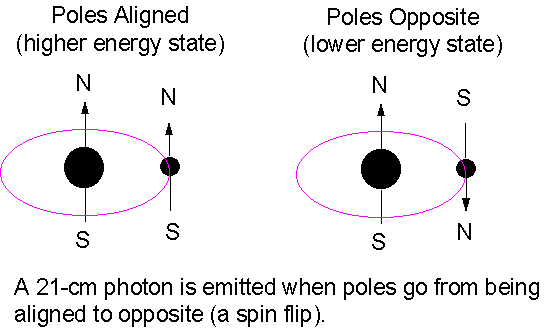
Interstellar Radio Lines- 21cm "spin flip"
Where interstellar atomic gas is cold, hydrogen is neutral and in it's ground state. In it's ground state hydrogen has two energy levels separated by only a very small energy gap. This phenomenon occurs because both the proton and the electron have an intrinsic spin, and as a moving charge generates a magnetic field a magnetic moment is created. the magnetic moment of a spinning particle is represented by a vector which is proportional to the vector angular momentum of the particle.
So both of the electron and the proton can be treated as tiny bar magnets, these can either for parallel or antiparallel to each other. In the parallel a higher state of magnetic energy as they will repel so this forms the higher energy state. if they are antiparallel to each other then a lower energy state will be formed. We refer to this as hyperfine splitting of the ground state of a hydrogen atom. We can observe the transition between these two states as a photon of wavelength 21cm is emitted, which is accompanied by a relative spin flip of the electron.

Atoms in the excited hyperfine state make a spontaneous downward transition only once every few million years as this transition is strongly forbidden. This means that we cannot recreate this emission in a laboratory, however as there is a a large amount of neutral hydrogen in the ISM then it is observed. This technique is very important as it allows us to measure the distribution of gas in the interstellar medium and we can produce maps of the galaxy like the one below:
.jpg)